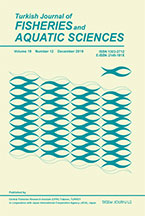Horticultural Studies (HortiS)
2018, Vol 35, Num, 1 (Pages: 51-60)
Effect of different irrigation applications on yield, yield components and water use efficiency of table grape under Manisa conditions
2 Adnan Menderes Üniversitesi Ziraat Fakültesi Biyosistem Mühendisliği Bölümü, Aydın DOI : 10.16882/derim.2018.372279 Viewed : 3028 - Downloaded : 1586 A field study was conducted to investigate effects of full and deficit water level on fresh yield, and quality parameters of seedless grape using drip irrigation system in the Alaşehir plain, Manisa during the 2016 growing season. Treatment layout was conducted to a randomized complete block design as three replications. In the trial, two known development stages (budburst-flowering; flowering-veraison) of the plant were considered and a total of 8 different drip irrigation treatments were investigated. The irrigation treatments were based on soil water depletion replenishments from the effective root zone (0-90 cm). As a results of the study, different irrigation treatments significantly (p<0.01) affected the fresh grape yield and yield components. The highest average fresh grape yield (3960 kg da-1) was obtained from the full irrigated treatment (S1). Irrigation water was applied 13 times during the growing season for the treatments. The amounts of applied irrigation water 554.8 mm and seasonal water consumption value 616.2 mm were determined from the full irrigation treatment (S1). The yield response factor (ky) were found to be 1.21 and 0.85, for the budburst-flowering and flowering-veraison stages, respectively. Seasonal ky value of 1.04 was determined based on irrigation treatments. Water use efficiency (WUE) values varied from 5.91 to 10.63 kg m-3 and irrigation water use efficiency (IWUE) values varied from 6.51 to 9.72 kg m-3 for the irrigation treatments. It is concluded that full irrigated treatment (S1) could be used under no water shortage conditions during the growing season to obtain highest fresh yield and quality parameters. In the case of limited water supply conditions, deficit irrigation treatment (S2) could be used to maintain satisfactory growth and yield. Keywords : Drip irrigation; Phenological stage; Deficit irrigation; Water use efficiency














